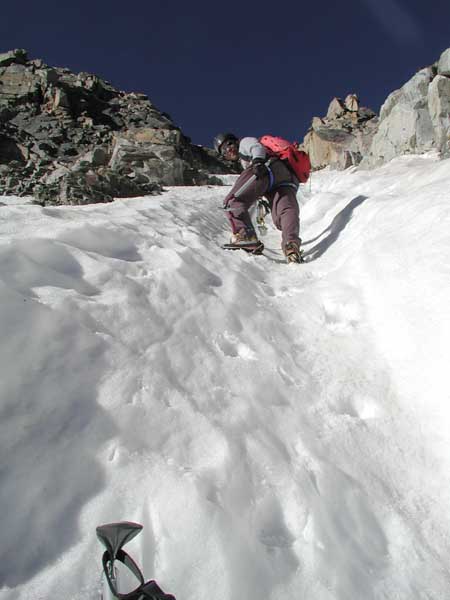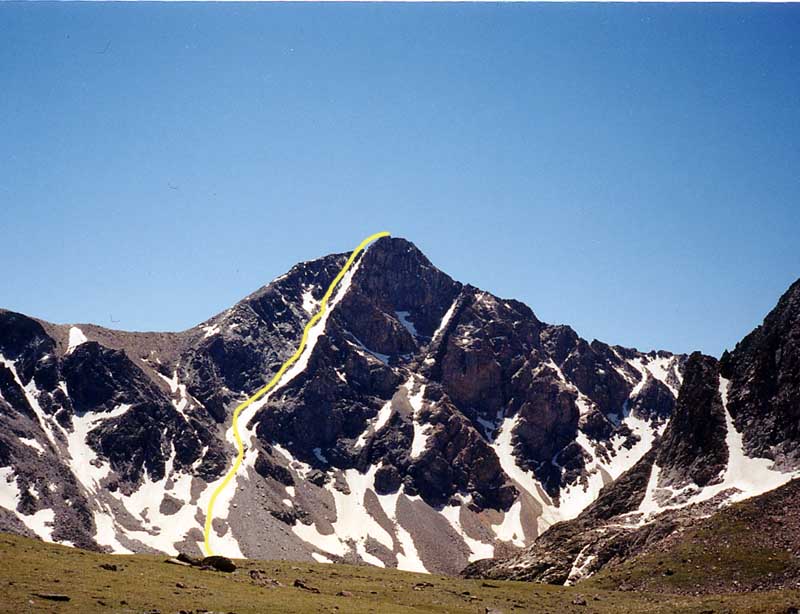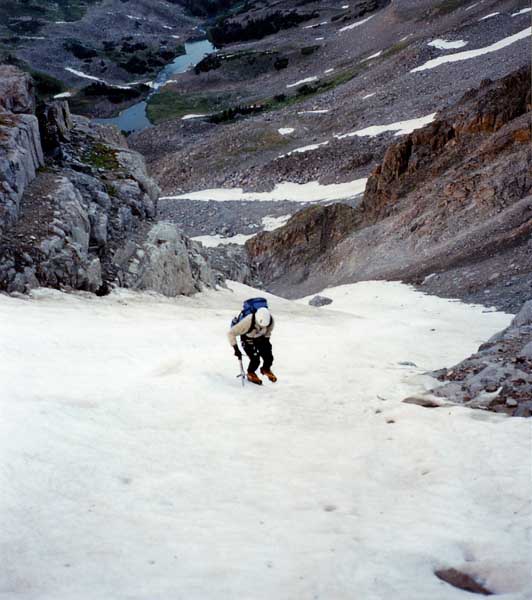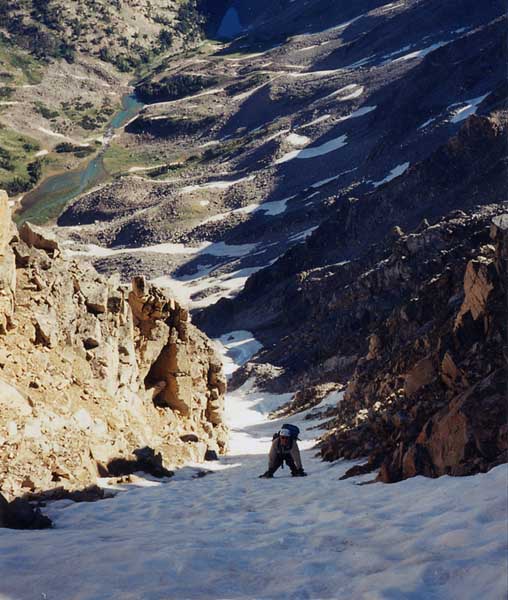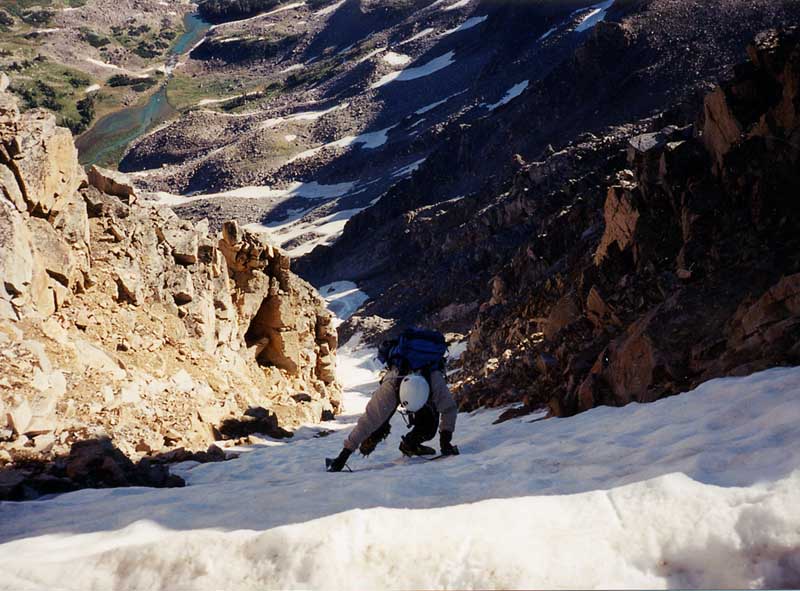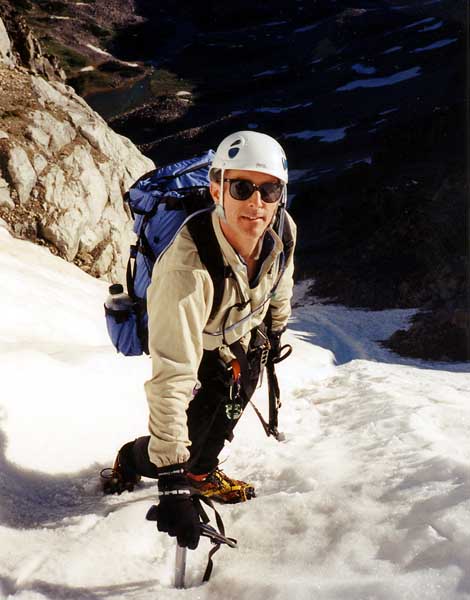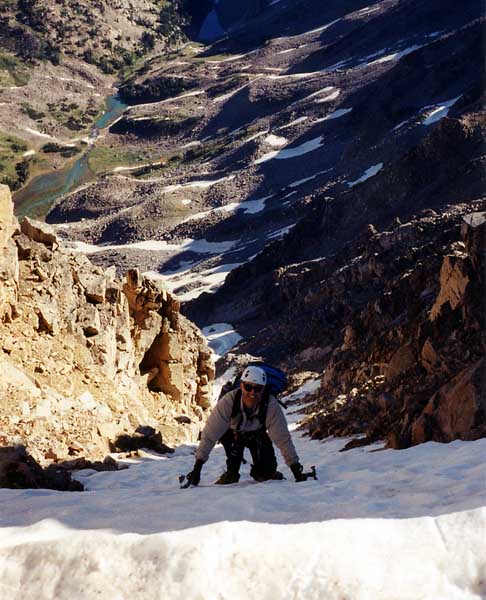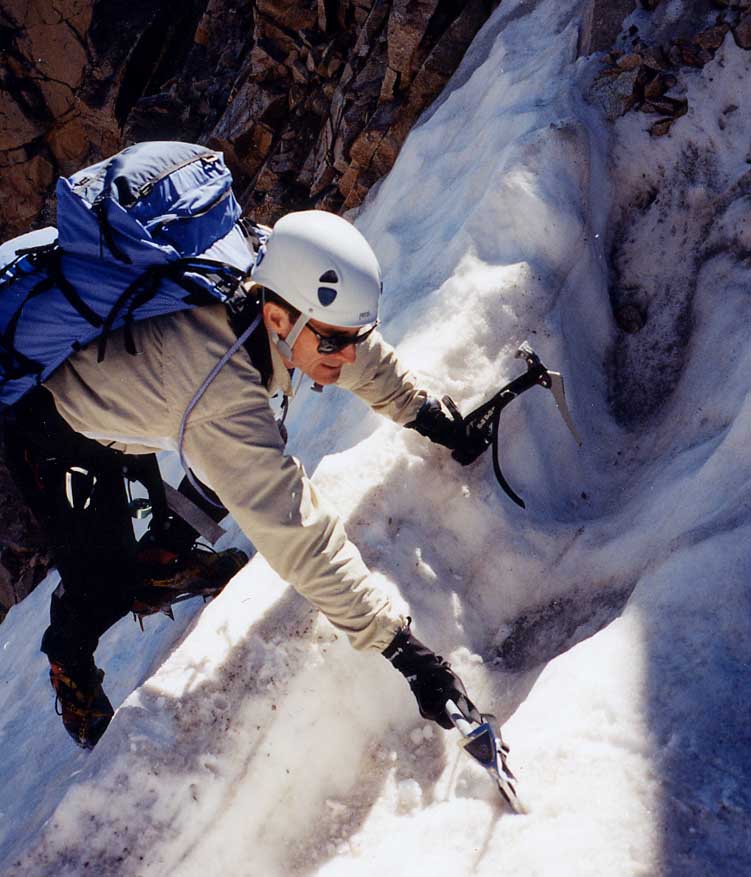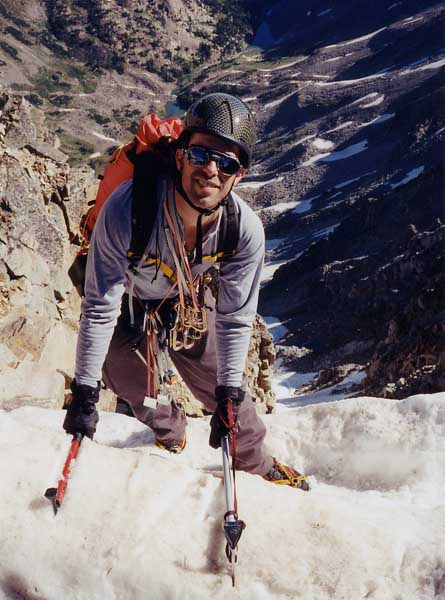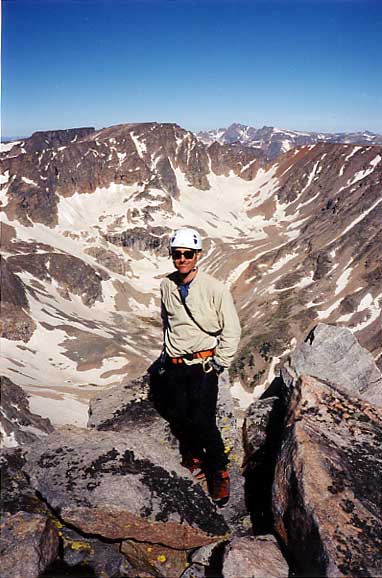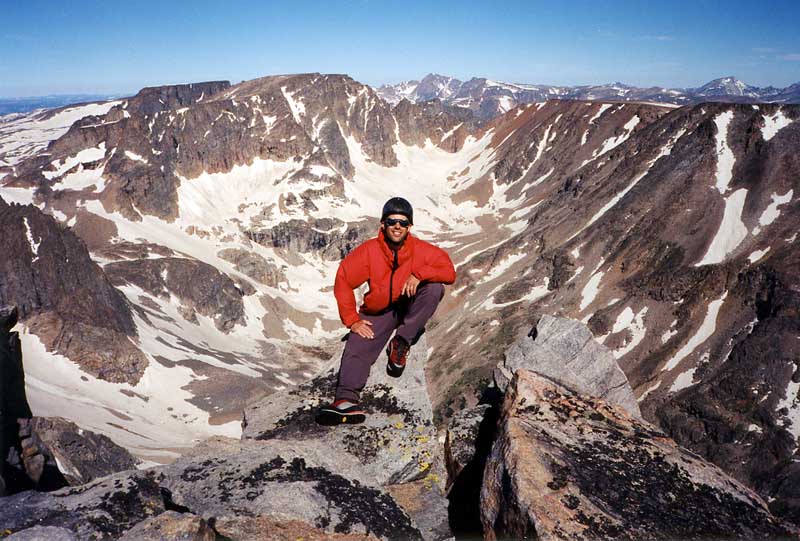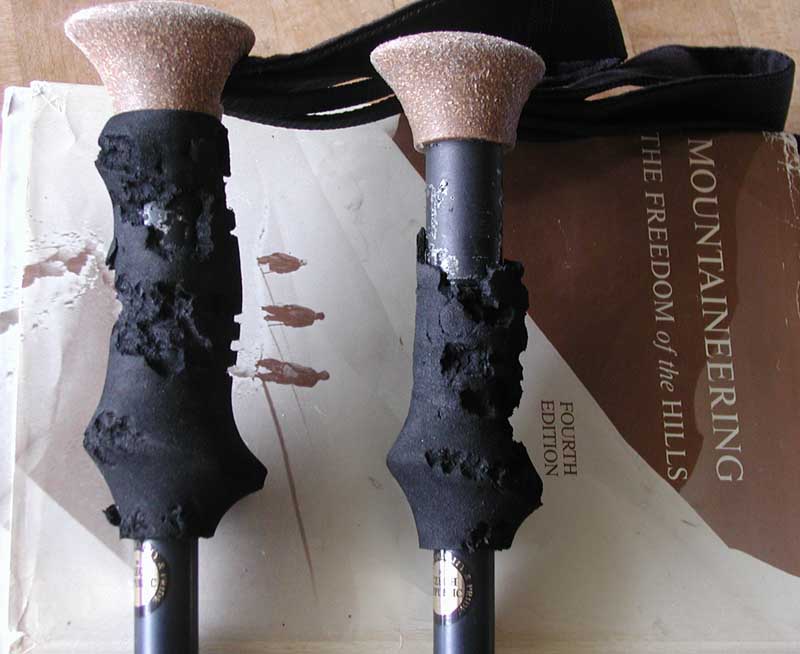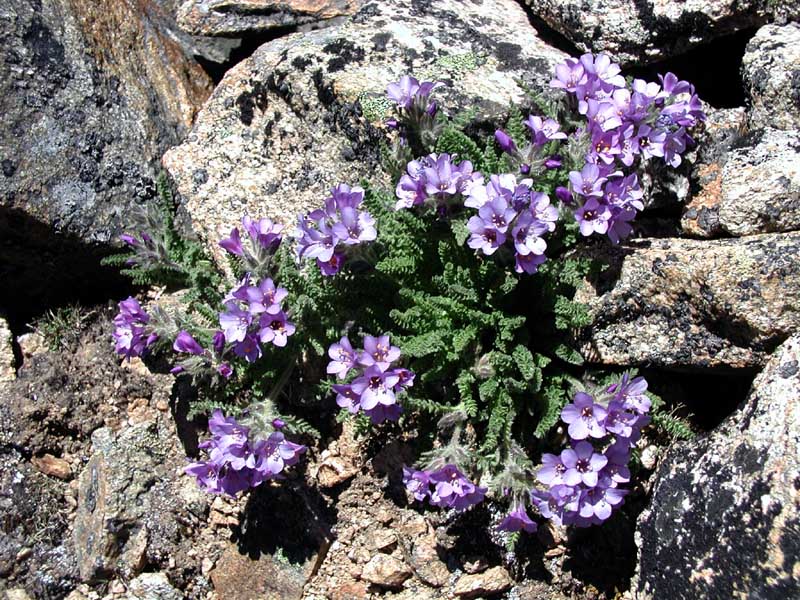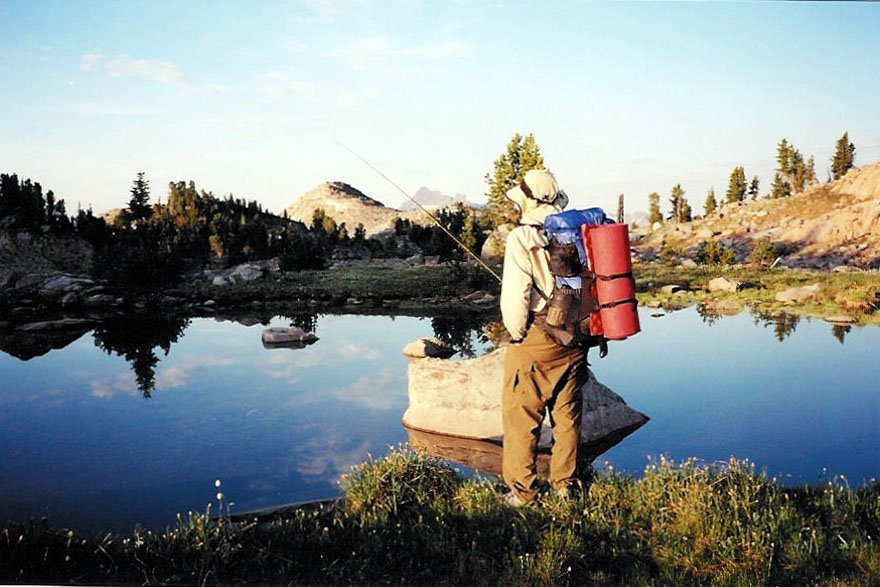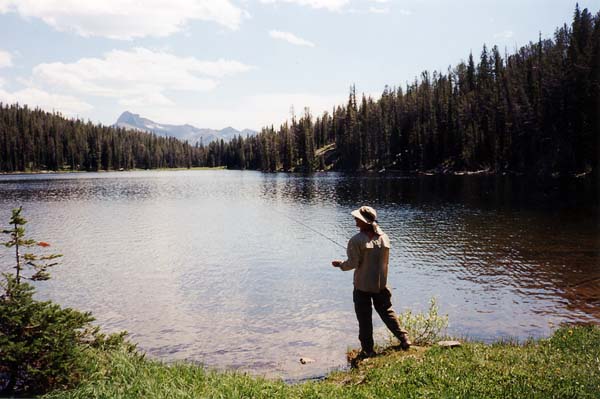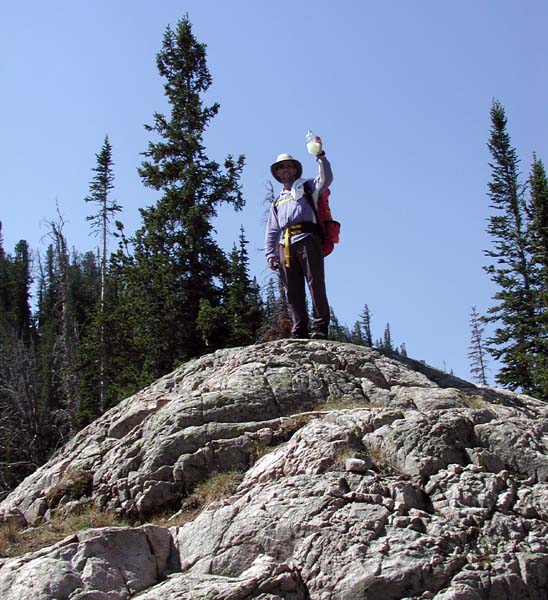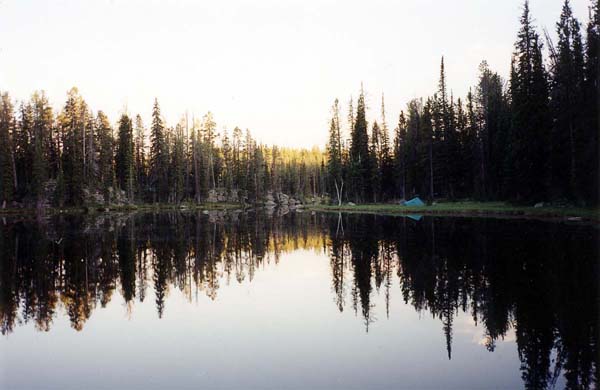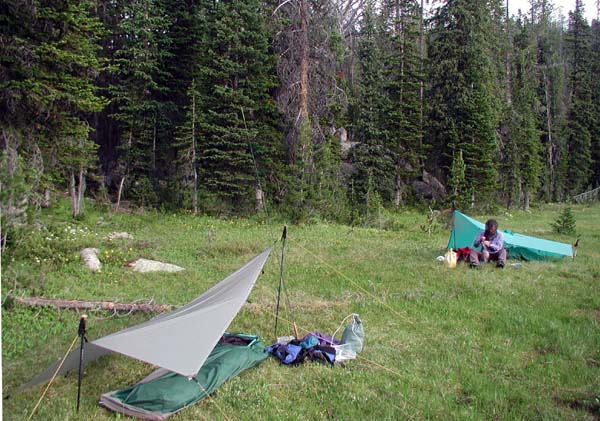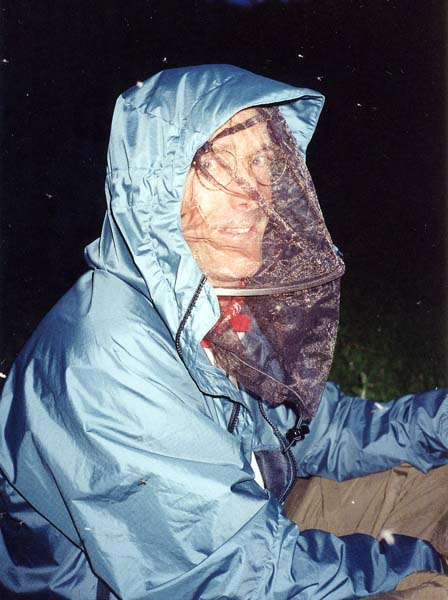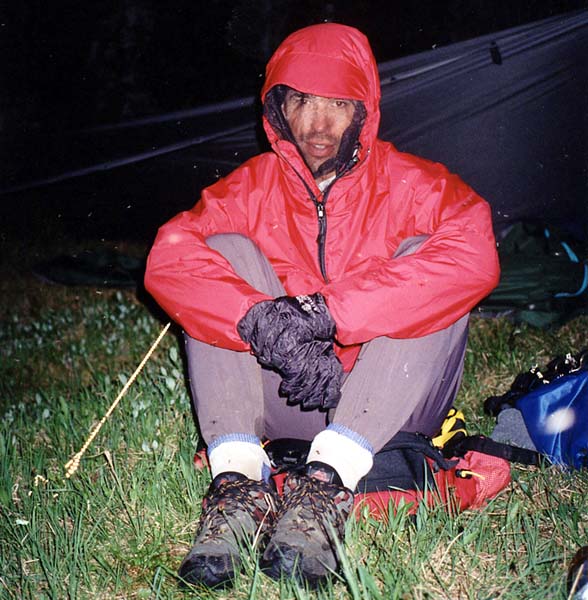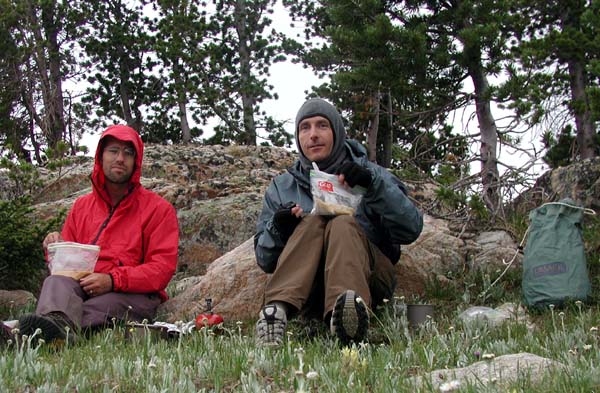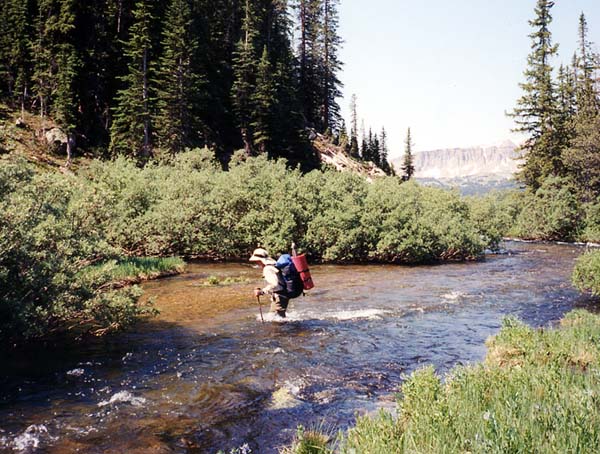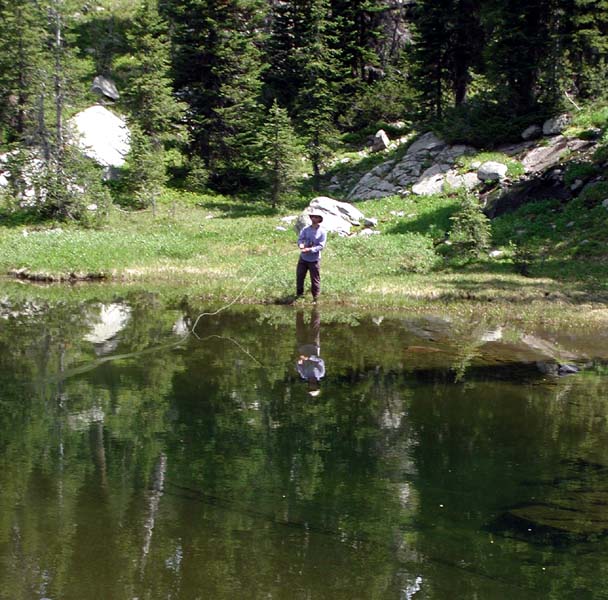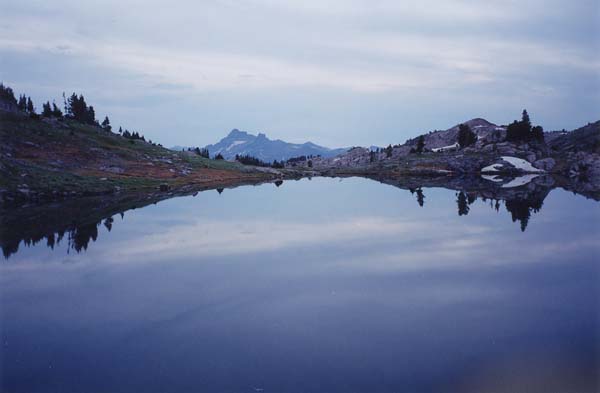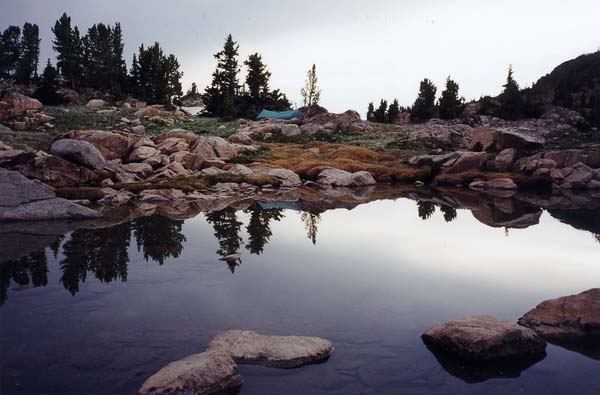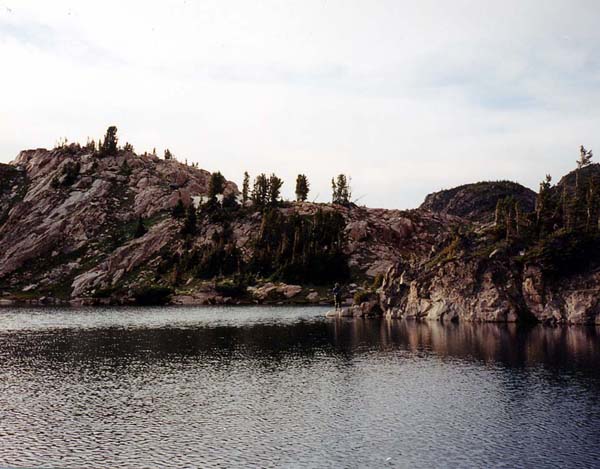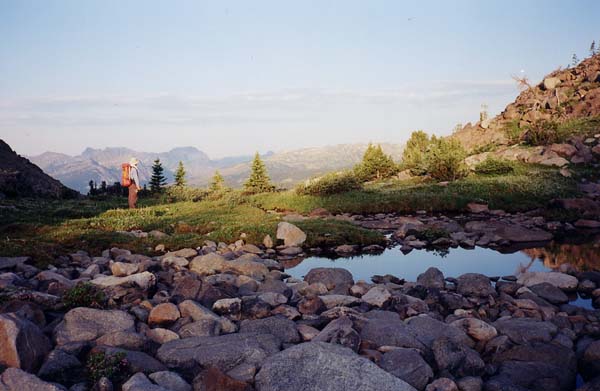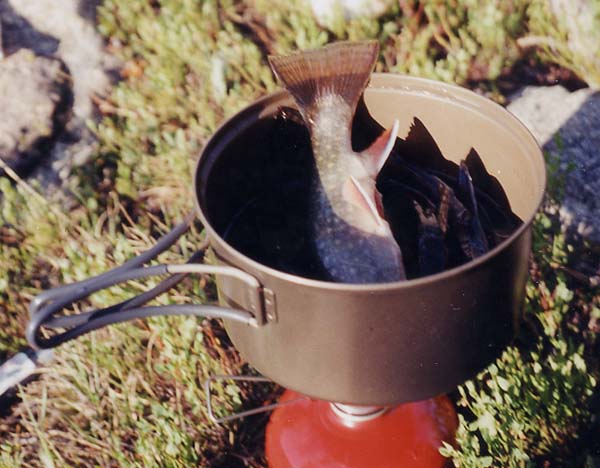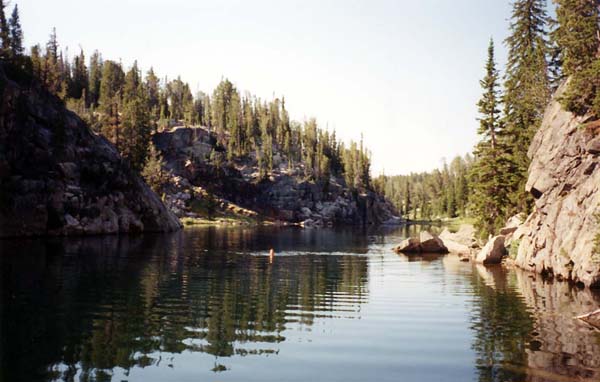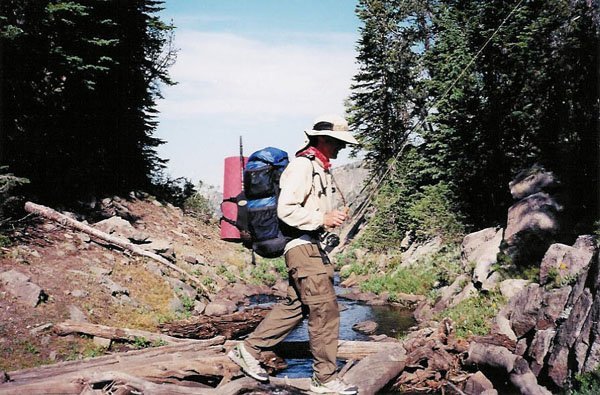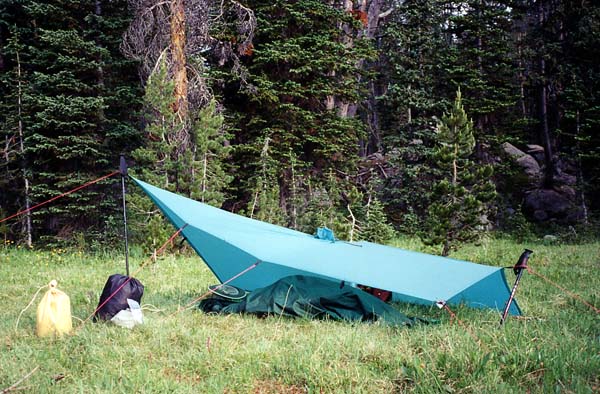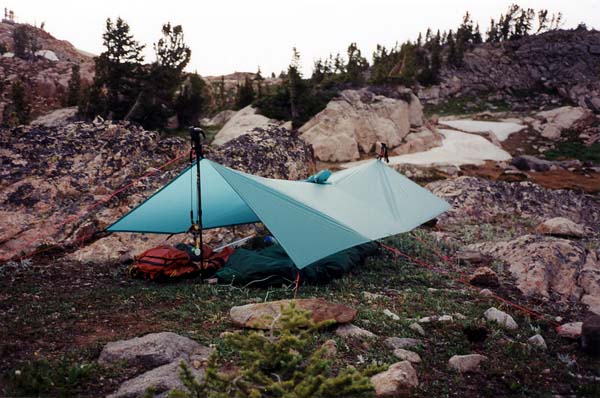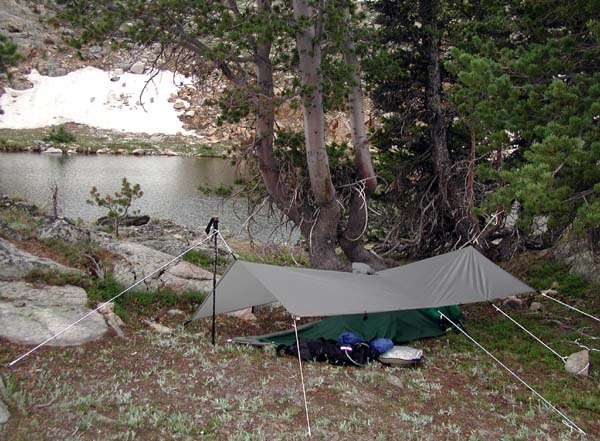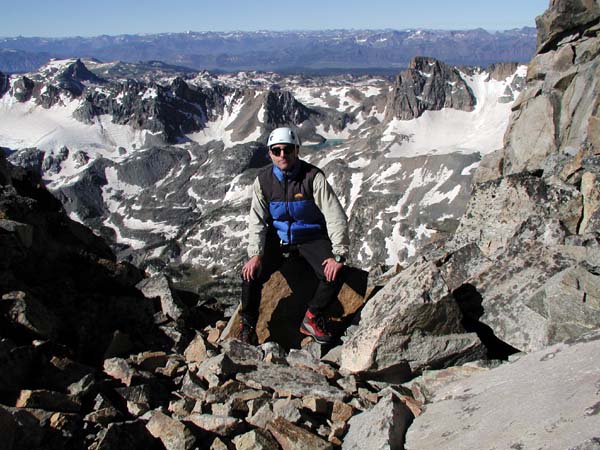Whitetail Peak and Beartooths (an ice climbing and fishing trip)
Montana 2002
Ascent of Whitetail Peak Via Whitetail Gully
Ryan ascending the steeper upper sections of the couloir.
The route up Whitetail Peak as seen from our acclimatization day at the high altitude fishing lakes.
Alan Starting up the lower section in classic pied à plat.
On steeper ice and using both tools.
The sun starts to hit the upper section of the couloir. Not good!
Taking a breather.
Negotiating over a step.
Ryan very near the summit.
Success — the top of the couloir.
A short section of class 3 rock and Ryan is at the summit. Fabulous 360 degree view of the Beartooths.
My goat-chewed trekking pole grips.
Our obnoxious camp mascot and eater of my trekking pole grips.
Sky Pilot, the climber’s flower. It only grows between 10,000 and 13,000 feet. These flowers are around 11,500 feet tucked in the middle of a talus slope.
Beartooth Fishing
Ready to start another day fishing and hiking in the Beartooths
Overview
With their heads swollen from a successful ice climb of Whitetail Gully and their feet swollen from too many miles in ice climbing boots, Alan and Ryan head off for some relaxing backcountry fishing in the Beartooth Absoraka Wilderness.
Evening Day 3 – Thursday, July 11, 2002
After our long day climbing Whitetail, even after dinner in Red Lodge and a soak in a hot tub, there still was little enthusiasm for hiking in and preparing for a one-day summit attempt on Montana’s high point, Granite Peak. Both of us were sore, and our feet did not relish another 18 mile romp over Beartooth talus, even in trail runners.
On the other hand, there was a lot of enthusiasm for unwinding on a light and fast 3-day backcountry fishing trip. Since I had never fished in Montana’s fabled trout waters, it took little effort on Ryan’s part to convince me to try and catch some Yellowstone Cutthroat from some remote Beartooth Lakes. Ryan bought the latest edition of the Beartooth Fishing Guide in Red Lodge and did some research on which lakes might be fishing well. Before we went to bed we selected an area with some promising lakes to check out.
Day 4 – Friday, July 12, 2002
After breakfast at the motel, we got our morning espresso from a little eatery in downtown Red Lodge and hit the supermarket for extra food. We purchased such healthy delicacies as 70% fat beef sticks and Red Vines. Then we headed off for a trailhead near Cooke City. To get there we drove the Beartooth Highway, one of the highest paved roads in the lower 48. The alpine scenery was spectacular and was a special treat for me who had never been over the road. After fully testing out the ground clearance and traction of our rented 4WD vehicle on a Montana logging “road” we reached Lady of the Lake trailhead around 1:00 pm. (Ryan didn’t seem to understand about slowing down for the frequent drainage chasms that crossed the road. Maybe it’s a regional thing; Ryan’s response: “It-t-t’s a r-rent-t-tal d-d-dude. What the heck is that in the r—! Ow! Whoa!! These climbing helmets are awesome! Alan, why’s yer helmet back in your pack? Is that blood, man?”)
Catching a few brookies at Lady of the Lake
We shouldered our delightful 16 pound packs and immediately forded the Clarks Fork of the Yellowstone River and followed Lady of the Lake Creek to the lake of the same name. Here we had a snack, sampled respectable fishing for brook trout, and discussed what we should do next. Ryan convinced me that we should head off cross country to some largely unknown lakes under”experimental fisheries management.” The first of these lakes was Swamp Lake, the last Marsh Lake. With names like that I should have known better…
Ryan with Cytomax bottle, trying to figure out where the heck we go next
The route, entirely in the woods and without views, was challenging. Ryan and I navigating together managed to hit our destination, Swamp Lake, right on the nose. I don’t think either of us would have fared as well separately. Swamp Lake is what one would expect from the name, a shallow, warmish lake with a few boggy areas around the shoreline, and with hardly a dry place to put your feet or set up camp. There air was calm and even in mid-afternoon the mosquitoes were plentiful.
Swamp Lake – Ryan’s tarp is the greenish-blue thing on the far shore
Ryan had chosen this lake because it was said to harbor trophy rainbows. As we were eating an early dinner at the lake’s outlet, we did see a massive surface wake that could have been either a US Navy torpedo test or a trout of unknown proportions. We also saw an otter and a porcupine. The otter immediately dove under the water and the porcupine immediately went up a tree.
During dinner we found a ripped hunting guide’s jacket that Ryan thought might be the result of a bear attack – not a cheering thought in grizzly country but then again it could have been the work of a brother of our friend the mountain goat. Ryan took down the name of the guide service on the jacket to make a call when we got back. Since we were in grizzly country, we were careful to cook at one end of the lake at the established campsite where a bear was more likely to come, but to sleep at the other end of the lake.
The fishing guidebook said the fisheries management policies at these lakes had not yet been evaluated, but I can tell you the fishing at Swamp Lake stank. We never saw a rising fish and despite many fishing strategies, we caught nothing. Ryan claims to have spooked two more huge rainbows but I didn’t see a fish, not even a minnow. The water was clear and the surface mirror flat. Our odds of catching large wild rainbows even if they were in the lake were just about nil. Just about any cast or presentation would send them charging to the other end of the lake. Ryan says he may pack a float tube back to Swamp Lake and see what he can do. I say bonne chance. But make no mistake: we did see a large wake…
Our camp on the soggy shores of swamp lake – Ryan is sitting on stuff sack to keep his behind dry
Our camp was so damp that if you took four shoeless steps your socks would get wet. Fortunately the silnylon bottoms of our bivy sacks did keep our sleeping bags dry. Mosquito pressure steadily increased towards dusk until each of us had a personal haze of the hungry ones humming around our heads. We’d already been using our head nets and DEET for hours.
It was then that I began to question Ryan. I couldn’t figure out why we were sleeping (floating?) in a bog on the shore of a windless, mosquito-infested lake. For three uncatchable rainbows? I’d been hoping he had a little more sense than that. But then fisher folk will do a lot of crazy things if they think there’s even a remote possibility of landing that big one. My brother is exactly the same. Been that way for years.
Alan having fun
White things are skeeter wings caught in the flash
“There were a few bugs at this lake.” So great why was Ryan wearing his head net, gloves, and Jackorack in such warm weather?
Ryan’s journal notes about the mosquitoes: “There were a few bugs at this lake. Alan looks annoyed. Maybe he’s frustrated with the lack of spices in our dinner?”
Alan’s note: My frustrated look was more likely envy of Ryan’s bivy with the zip-in mosquito netting. This inequity in accessories may account for much of our difference of opinion about mosquitoes. (Possibly I wasn’t paying attention and Ryan was nipping harder at the bourbon than I thought.) Anyway if Ryan thought the bugs were so great why was he wearing his head net, gloves, and Jackorack in such warm weather and why did he beg me for my DEET (he forgot his) three hours before sunset?
Anyway, without bug netting on MY bivy, the mosquitoes were so intense that even the bourbon didn’t help me to sleep. I like to think I have decent mosquito tolerance, but the hundreds of buzzing skeeters kept at bay just an inch from my face by the head net were too loud for me to doze off. I finally had to zip the bivy hood shut to get to sleep. It was a bit warmer and stuffier inside the bivy that I like for sleeping but better than the drone of the hungry ones. Nice that the EPIC bivy top was breathable enough that I didn’t asphyxiate. As I dozed off, I cringed wondering what lovely destinations Ryan had planned for the next day.
Day 5 – Saturday, July 13, 2002
We woke at dawn, packed, and left in 10 minutes without eating or cooking breakfast. We motored away from Swamp Lake in a hurry, glad to put the worst of the mosquitoes behind us. Unfortunately, on this trip there was no place day or night that was free of mosquitoes, it was only a question of how many.
Enjoying one of Ryan’s excellent meals.
With thundestorms all around we’re also enjoying an ununsual respite from mosquitoes
Food
We returned to Lady of the Lake and had pleasant breakfast. Did I tell you how well we ate on this trip? First, Ryan has these fantastic homemade meals that he puts in Stand and Zip bags. He was kind enough to make a whole set for me. The familia breakfast cereal, with grains, nuts, and freeze dried fruit like raspberries is to die for. We had it hot but Ryan says it’s at least as good cold.
Ryan’s dinners are equally good. He gets these great dried soy chunks from his local coop that hydrate into a perfect texture. The two meals he brought were chili mac and corn chowder. Both were full of sauce, spices and veggies. They are about two the three times better than commercial freeze dried meals and have a whole lot less sodium. For a few more easy calories, I brought some canola oil which we added after our meals had been rehydrated.
Coffee
I brought some super Café Chiapas Zapatista coffee that I ground fresh the night before the trip. I make a serious cup of trail coffee with a caffeine buzz that helps a man get up and do what he has to do. What the heck do you think launched us up Whitetail Gully? Ryan raved about the coffee all trip and I’m sending him a bag of it this week.
We boiled water for meals in my 1.3 liter Evernew titanium pot. We used it to poach trout and we also used it for brewing coffee. Yes, we brewed about a liter of coffee in the morning and Ryan had another 16 oz cup of coffee in the eve (“Helps focus me vision on them reeeally tiny stars,” he says). The man has a serious caffeine Jones.
After breakfast we headed up canyon to Zimmer Creek and then along Sky Top Creek before going off trail to a couple of small lakelets with good brookie fishing; then we moved on to Cliff Lake.
Fording some swift water. We waded through many steams and just kept on going.Our pants and shoes were dry in a short time.
At this point we were in high spirits — rested from Whitetail, full of warm breakfast and pleasantly buzzing with caffeine. With sub-15 pound packs and fly rods in hand, we were ready to do some serious fishing. Ryan and I hiked and fished our way from Cliff Lake to Peanut Lake and Moccasin Lake, and finally to Weasel Lake. With our trekking poles in our packs and our fly rods ready we cast a line in almost every body of water we came to.
Ryan casting to spooky brook trout in gin clear water.
We had some exceptional catches of brook trout as big as 15 inches in a small, unnamed lakelet along the way. We would never have fished it if we hadn’t seen a few risers out the corner of our eyes. Ryan says Beartooth fishing is like this. You need to be alert. Some of the smallest and most innocuous lakes and tarns sometimes have excellent fishing and some the larger, fishier looking lakes can be disappointing.
Weasel lake at dawn. The glass smoth surface takes a beautuful photograph but makes fishing hard
After Moccasin Lake we moved on in a hurry because thunderstorms had been threatening for over an hour. Nothing like darkening skies and the sound of nearing thunder to quicken your hiking pace. Ryan was looking forward excitedly to a torrential rainstorm in which to test our silnylon ponchos. I preferred getting to the lake before the rain arrived and testing them in tarp mode, over my bag and bivy.
Ryan Exonerated
Weasel lake, our ultimate destination, was large and looked fishy. Ryan picked it because it was in year 5 of its 8-year stocking cycle. Around 4 to 6 years after stocking, lakes have the best combination of large fish and quantities of fish. I was delighted to see rising fish as we approached.
Ryan’s tarp at Weasel Lake
We beat the thunderstorms by about 15 minutes. Just enough time to pitch our ponchos/tarps in low storm mode before they arrived. Luck of the draw, but with storms raging and thundering all around us, all we got was gusty wind and a splattering of rain.
Fishing can be good with overcast skies and rain. Not ones to be afraid of standing around with a 9 foot rod of carbon in an electrical storm (at least when there are rising fish — is this the first time you’ve thought we were a bit demented?) Ryan and I went down to the lake and had at. Ryan struck first with a nice 14-inch Yellowstone Cutthroat in just a few minutes. This was to be the best fishing of the day. The overcast skies and the windruffled surface had the fish rising and our presentations disguised.
Alan fishing Weasel Lake. He’s barely visable on the point.
The wind ruffled surface of the water and overcast from adjacent thunderstorms made for good fishing.
As the storms left, the lake surface calmed and the fishing got a lot harder. By evening Ryan and I were delving deep into our fly boxes for tiny stuff and lengthening our leaders to 10 feet and longer with fine tippets. Ryan kept mumbling about his midge box that he’d left at home. He did have some success with a #22 Baetis Sparkle Dun that he cut down to resemble a midge pupa. I had brought two fly boxes to Ryan’s one and a much larger assortment of flies. I was able to get some fish with a #20 BWO emerger, and some with my old standby, a Parachute Adams in size 20 or 22, which I fished just below the surface. Ryan switched to the Adams Parachute pattern with success as well.
In the end it was a perfect afternoon and evening of fishing. A couple of our fish were 16 inches, maybe a bit larger, which is a good fish by Beartooth standards (Ryan has caught fish well over 20 inches in the Beartooths.) The fishing was challenging enough to keep us entertained but not so hard that we were breaking our rods in frustration (we got close a few times). What a wonderful introduction to Beartooth backcountry fishing and Yellowstone Cutthroat Trout. Thank you Ryan!
Oh, I forgot to mention. As soon as the winds from the thunderstorms died down the mosquitoes were murder. Sounding like a familiar story? At least at Weasel Lake the fishing was good enough to warrant the torment. These mosquitoes were the worst of the trip (Ryan’s journal reads succinctly: “Bugs.” Alan’s response: Yeah, Ryan’s so tough that he chews his way through the thicker clouds of “bugs!”).
Anyway for some reason known only to him, Ryan fished the whole time in a head net and again borrowed my DEET for his hands. I fished in a fleece balaclava with DEET on the exposed portions of my face. Even so, I got dozens of bites on my nose and between my eyes and the balaclava. For my hands I alternated between fingerless fleece gloves (hard to fish in) and DEET. Again, I got quite a few bites. Surprisingly, the mosquitoes for the most part couldn’t penetrate my Rail Riders Ecomesh shirt.
During dinner Ryan and I both got a hundred bites on ankles exposed by raised pants hems. Right through our socks! As at Swamp Lake, the mosquitoes did not abate during the night. This made for some mad dashes for a nighttime pee. Don’t want to keep things exposed for too long. During my stay at Weasel Lake, I think I got bitten dozens of times just about anywhere I could be bitten. Fortunately, I have a fairly high tolerance for mosquitoes, especially when there’s fish to be caught. Again Ryan had the better deal with the zip-in mosquito netting on his Oware bivy.
Ryan heading off towards Moccasin Lake for breakfast.
Day 6 – Sunday, July 14, 2002
We woke at dawn and again left camp quickly without breakfast. The surface of Weasel Lake was like glass and we were not interested in any more midge fishing to selective trout. Besides, we had other plans. Around 7:00 AM we arrived at Moccasin Lake and caught two fat brook trout each. Into the pot they went to be poached with a little oil. A delicious trout breakfast, a large cup of strong coffee, and all was well with the world.
Breakfast: Four brook trout – perfect eating size
Ready to poach.
From Moccasin Lake we traversed over to beautiful Splinter Lake (Sliver Lake on some maps). The lake truly is a splinter. It is so narrow that it resembles a fjord more than a lake. There is an idyllic waterfall cascading into the middle of it. It was so perfect that it looked like the ultimate mountain lake for a glossy calendar photo. Ryan caught a couple a nice brook trout at the far end of the lake and I took a dip. The cold water felt great on my mosquito bites.
Alan swimming in beautiful Sliver Lake
Now it was time to hammer out. I wanted to be back in time to take Ryan, Stephanie and Chase out to a relaxed dinner in Bozeman. We passed three groups of non-ultralight backpackers who seemed almost not to be moving by comparison. One woman was wearing shorts. Her legs looked like what they must have been last night — a feeding station for mosquitoes. Shorts? And still wearing them? She might as well have put up a neon sign advertising “eat here.” Well, on second thought, if I had legs that good I’d might shave them and suffer the shorts too.
Ryan and I stopped at the Grizzly Cafe in Cook City. It’s something of a local color place and it’s Ryan’s favorite place to stop on his way out of the Beartooths. We were sandwiched in between a large biker group in leathers with bandanas tied around their heads and a couple of yuppie families with Orvis hats. A strange contrast but I liked the bikers better (Ryan’s journal: “Hell’s Angels to the left and Orvis catalog models to the right. At least the milkshakes are good”).
Given the venue, I couldn’t bring myself to order the veggie burger on the menu and instead had the special: cheeseburger, fries, and a milkshake. It was my first cheeseburger in at least 15 years but I suffered no ill effects. The strawberry malt was thick and superb. Nothing like ice cream after a hot dusty trail. (Ryan: “Alan tried to order a veggie crap something-or-other but I told him that we’d have none of that in a backwoods Montana town. He was to eat meat and like it if we wanted to walk out of this eat joint without getting shot.”)
From Cooke City we drove through the northern section of Yellowstone Park. Ryan had to stop every 10 minutes or so to show me some neat trout stream that we would fish in the future. My jaw just kept dropping lower and lower was we passed one unbelievable river after another. My favorite may have been the Gardner River in which you can soak in sulfur hot springs (“The Boiling River”) where they empty into the river. Ryan says he stops here on the way back from most trips and has a soak while he fishes the river. Unfortunately we were too short on time to for me to have a shot at this dual bliss.
Oh, we did get a good look at a young male Grizzly Bear on our way through the Park.
Far too quickly we had exited the north entrance of the Park at Gardiner/Mammoth (I have a photo of myself here) and now headed out along the Yellowstone River through the towns of Corwin Springs, Chico, Pray, Emigrant, Livingston; finally we were on our way to Bozeman. Along the way we stopped (just to look) at Depuy’s Spring, one of Montana’s legendary spring creeks.
We arrived in Bozeman at around 5:00 PM. I took Ryan, Stephanie and Chase out as a small thanks for their hospitality. After dinner, and after putting Chase to bed, Ryan and I had a couple of stouts with ice cream. Stephanie visited with us but was virtuous and just had ice water. We all chatted until after midnight. Ryan and Stephanie are wonderful hosts.
In Summary
All I can say is a million thanks to Ryan who planned the trip. Between the successful ice climb and the superb backcountry fishing, I don’t think I’ve been on a finer one. Then there’s always our next trip, which may be even better.
– AD, Arlington VA; RJ, Bozeman July 21, 2002
GEAR NOTES
Packs
Alan tested out his 27 oz GoLite Speed Adventure Racing Pack on this trip. It was ideal for a light and fast crosscountry fishing trip. He spent a lot of time hiking and fishing with this pack on. The foam-and-mesh back with its air channel was a blessing in the heat of this trip. The pack was so comfortable that much of the time he forgot I had it on. He rarely bothered to take it off.
Alan on the move with his GoLite Speed Adventure Racing Pack and rod ready to fish
The pack has tons of external storage. Its four side pockets held a Cytomax bottle, fishing equipment, camera, and lunch food. All were easily accessible without delving into the pack. Alan put most of my other small doodads in the top pocket of the pack. Oh how I do love a top pocket. I used the helmet holder to secure my Mt. Washington ground pad and put my Silponcho (and trekking poles when I was fishing) in the large rear pocket. With all this external storage, I didn’t have to go into the main bag of the pack except to make camp at night.
The pack comes with a 3 liter Platy Zip Hoser hydration system built in. The bladder is right against your spine for great balance. The large volume was a plus in the hot dry weather of this trip. We went through 6 to 8 liters of water a day. The hipbelt took some weight off of his shoulders and was a nice load stabilizer. In addition the hipbelt pockets were great for packets of Gu and Aleve (vitamins for aging jocks).
One final plus, the more durable fabric on the bottom of the pack is a welcome design change for GoLite (in comparison to the Breeze which has a less tear and abrasion resistant Spectra Ripstop). Alan felt this pack bottom was much better for off trail use. It’s nice not to constantly pay attention on whether you’re putting your pack down on something sharp. Also, one always seems to bump the pack bottom on rocks while boulder while or sharp branches while bushwhacking.
Ryan used his incredibly versatile McHale, stripping it down to include just its frame, top pocket, and side pockets. With his Mt. Washington pad rolled inside the pack, there was room to spare for this 3-day trip (the main packbag is about 2,800 ci).
Shelter System — Integral Design Silponcho and Oware Epic/silnylon Bivy
We were very pleased with our shelter system of ID’s Silponcho as tarp, an Oware EPIC/silnylon bivy and Leki Ultralight Ti trekking poles. Both of us are taking this exact system on future trips this summer.
This is the standard A-frame/lean to pitch we used
Ryan’s tarp in a storm pitch
Both for day hiking and for our climbing days, we put our sleeping pads, sleeping bags and surplus gear in the bivy and staked it to the ground. This kept everything from blowing away while we were gone from camp. With the tarp pitched over the bivy, we had a fully weather resistant sleep and shelter setup in camp. When we came back our bags were fully lofted ready to sleep in—no setup, no fuss, no bother. This works much better than putting everything in a stuff sack and jamming it between boulders or in the bushes. Nice not have to re-pitch camp when you come back from a long day hike or hard climb.
The ID Silponcho and Oware EPIC/silnylon bivy worked well in a variety of conditions from frosty sub-30-degree nights below Whitetail peak to boggy and humid conditions on the damp shores of Swamp Lake. Everything under the tarp and inside the bivy stayed dry. The damp soil at the side of the lake did not seep through the silnylon floor of the bivy and there was no condensation inside the bivy.
Alan’s tarp in storm pitch an well sheltered behind a beak of trees.The green thing under the tarp is his Oware EPIC/silnylon bivy sack
The last few nights in the Beartooths were very warm with intense mosquito pressure that did not abate during the night. Ryan was in heaven with his bugnetted bivy. He had the hood tie-out secured to his tarp. Alan was OK with his spring-loaded headnet poking through the non-meshed hood opening on his bivy. He had a hard time getting to sleep on boggy shoreline of Swamp Lake. The hundreds of buzzing skeeters kept just an inch from his face by the headnet didn’t allow him to doze off. He finally had to zip the bivy hood shut to get to sleep.
The bivys were great on the warm 50-to-60 degree nights because we had bug protection without having to be in our sleeping bags. On still warmer night they were too hot for Alan, who slept in his bivy with only his GoLite Chill vest for insulation.
We had no significant precipitation on the trip although we spent a few very windy hours high on the Beartooth plateau with thunderstorms raging all around us. We got only the gusty winds and a splattering of rain. It was also a few blessed hours where we weren’t tormented by mosquitoes. Both tarps held up well in the gusts in a low A-frame storm pitch. We were both hoping for rain to test the water resistance or our shelter setup and to see how the Oware bivys handled rain spray under the tarp but it was not to be.
We brought only water-resistant jackets and no rain pants. The Silponchos, in poncho mode, were our backup to protect us and our packs in case of torrential rain. The EPIC of the Jackoracks is good but not that good.
FF Jackoracks
Both of us used EPIC Jackoracks from Feathered Friends. At under 9 oz the Jackorakck may be the most versatile shell on the market. They are great windshells, and will keep you reasonably dry in all but heavy precipitation. The Jackorack has a full hood that fits over a climbing helmet, and it has a generous brim. Between the breathable EPIC fabric, huge front vents, pit zips and a full front zipper, the Jackoracks arewonderful at regulating heat and moisture from hard exercise. We also found that they made great mosquito protection.
Ryan: “I found the EPIC fabric to be pretty warm for summer wind wear. I prefer the more breathable microfiber polyester of the GoLite Bark or the Pertex Microlight of a Montane Featherlite windshirt. However, the Jackorak has huge torso vents and pit zips that compensate for this, making it the most versatile shell jacket I’ve ever owned.”
Insulation
Alan took his GoLite Chill vest. He picked this vest for both his Climb on Whitetail and the fishing trip because he wasn’t taking fully waterproof raingear. The Polarguard 3D insulation in the vest would keep him a lot warmer if he got into some serious rain that worked its way through my EPIC shell. He also likes vests because they leave his arms free for activities like ice climbing and fishing. The Chill is a very efficient insulator. At 14.5 oz it has substantially more insulation than most synthetic fill vests like a Patagonia Puffball. Alan was toasty warm in the vest and Jackorak shell on the frosty mornings at the base of Whitetail Peak.
Alan warming up in his GoLite Chill vest at the top of Whitetail Gulley
Although it was too warm to wear the vest for most of the unusually hot weather on our Beartooths fishing trip—It was 103 degrees in Bozeman one day while we were gone—the vest was still useful. The last two nights of the fishing trip, temperatures dropped into the 50’s. Alan did not use his sleeping bag. Instead he used the Chill vest as his only insulation for sleeping in his bivy sack. He was warm and comfortable. Ryan was impressed enough with the vest that he may buy one for himself.
Ryan’s choice was a PhD Minimus down jacket (12 oz). The only time he really appreciated its warmth was preparing for the climb at 4 am on a 28-degree morning. But it makes a great pillow. Had Ryan let the weather forecast sink in a bit, he probably would have replaced it with a Puffball Vest (7 oz).
Ursack Bear Bags
Since we were in Grizzly country, we were serious about keeping our food away from bears. We both used Ursack Bear Bags for our food. These were light (5 oz) and, unlike bear cans, compress to the size of your food. This was good, given our small and lightly padded packs. We usually camped where there were no trees tall enough to hang food from. With the Ursacks we just tied the bag to a sturdy tree trunk about eye level. It took us about 60 seconds to put up or take down our food. Compare that to the time it takes to do a good food hang. In addition, to minimize attracting bears at night, we cooked most meals away from where we camped.
Schoeller Dynamic Pants
Alan wore a pair of Ibex Alp pants and Ryan a pair Arc’Teryx Gamma LT pants. We were surprised – and pleased – with the warmweather performance of Schoeller’s Dynamic fabric. These pants were the only bottoms we brought and worked well in 80 degree hiking weather. On this sort of trip we’d usually take nylon Supplex pants and expected to roast in the more durable and heavier Schoeller fabric. Instead we were cool and comfortable. We waded through steams in the pants and they were dry in a short time. The Dynamic fabric is extremely tough and survived a lot of bushwhacking with no signs of wear. Finally, the pants were very mosquito resistant, a necessity on this trip!
ALAN’S GEAR LIST
ITEM WT (OZ)
down bag (Rab Top bag – modified) in silnylon stuff sack 20.0
3/4 length closed cell foam sleeping pad
(Paramount Outfitters’ Mt. Washington) 7.0
bivy sack with EPIC top and silnylon bottom (Oware) 9.5
silnylon poncho-tarp (Integral Designs) 8.5
titanium stakes (9) and Triptease guylines in ziploc bag 3.0
GoLite Speed Pack 27.0
clothing worn (Supplex shirt, Ibex Schoeller Dynamic pants, merino running socks, trail runners, Supplex hat, bandana) n/a
EPIC shell jacket (Feathered Friends Jackorak) 9.0
Polarguard 3D vest (GoLite Chill) lots of loft! 14.5
other clothing (Patagonia R.5 zip-T, 1 pr extra socks, 200 wt balaclava, fingerless gloves) 15.0
personal cook kit (Snowpeak 21 oz ti mug, plastic spoon) 3.0
1/2 group cookwear (Snowpeak GigaPower canister stove, 1.3 L ti pot, lighter, empty wt of 8 oz fuel canister) 6.0
bear bag (Ursack TKO) and mylar liner 5.0
hydration (3L bladder, 1L sports bottle, Aqua Mira Kit) 8.0
emergency kit (blister kit, meds, whistle, pocket LED light) 3.0
toilet kit (toothbrush & paste, headnet, DEET, TP, Purell) 5.0
navigation (map, LED light, Suunto Vector worn, micro-compass) 2.0
camera (Olympus digital w. Li batts & 128 Mb card) 14.0
fishing (4-pc fly rod, cloth cover, reel, 2 box of flies, tippet, split shot, strike indicator, nippers, hemostats, floatant, lanyard) 19.0
TOTAL PERSONAL EQUIPMENT 11.2 lbs
breakfasts (2 x 6 oz ea) 12.0
lunches (2 x 10 oz ea) 20.0
dinners (2 x 6 oz ea) 12.0
coffees (2 x 2 oz ea) 2.0
Cytomax (4 oz) 4.0
carbo gel 6.0
1/2 fuel (net wt) 4.0
TOTAL PACK WEIGHT INCLUDING CONSUMABLES
(WATER WEIGHT NOT INCLUDED)
14.9 lbs
RYAN’S GEAR LIST
ITEM WT (OZ)
down top bag (Nunatak Arc Alpinist) in 1000 ci silnylon stuff sack 22.0
18″ x 36″ closed cell foam sleeping pad (Paramount Outfitters’ Mt. Washington) 4.0
bivy sack with EPIC top and silnylon bottom (Oware) 11.0
silnylon poncho-tarp (Integral Designs) 9.0
titanium stakes (14) and mason twine guylines (50 ft) in small ballistics nylon stuff sack 4.0
210d Spectra ripstop pack 2800 ci (McHale) with top pocket/fanny pack, two side pockets, and frame 52.0
clothing worn (Supplex shirt, Schoeller Dynamic pants, merino trail socks, trail running shoes, Supplex hat, bandana) n/a
EPIC shell jacket (Feathered Friends Jackorak) 9.0
down jacket (PhD Minimus) 12.0
other clothing (1 pr extra socks, Powerstretch balaclava, nylon/tricot gloves) 6.0
personal cookware (Snowpeak 21 oz ti mug, lid, ti spork) 4.2
1/2 of group cook kit (Snowpeak GigaPower canister stove, lighter, and empty wt of MSR IsoPro fuel canister) 6.0
bear bag (Ursack) 5.0
hydration (1.5L bladder, 1L sports bottle, Aqua Mira Kit) 6.5
emergency kit (blister kit, meds, whistle, pocket LED light, cell phone) 7.0
toilet kit (toothbrush, Dr. Bronner’s, Dermatone, headnet, TP, Purell) 5.0
navigation (map, LED light, Suunto Vector worn) 1.8
camera (Contax T3, case, extra battery, 3 rolls film) 13.0
fishing (5-piece fly rod, vinyl rod tube, reel, 1 box of flies, tippet, split shot, strike indicator, nippers, floatant, lanyard) 16.0
TOTAL PERSONAL EQUIPMENT 12.1 lbs
breakfasts (2 x 6 oz ea) 12.0
lunches (3 x 10 oz ea) 30.0
dinners (2 x 6 oz ea) 12.0
coffees (2 x 1 oz ea) 2.0
Cytomax (3 oz) 3.0
carbo gel (3 oz) 3.0
1/2 of fuel (net wt) 4.0
TOTAL PACK WEIGHT INCLUDING CONSUMABLES (WATER WEIGHT NOT INCLUDED) 16.2 lbs

